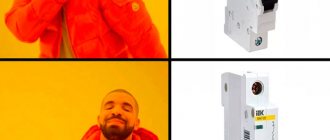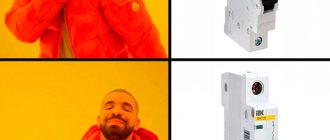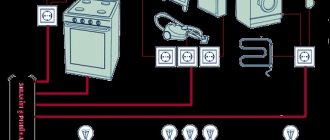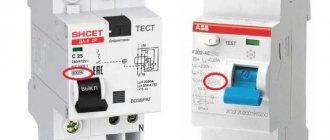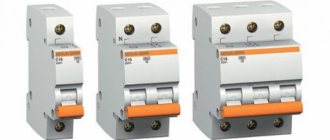Long gone are the days of ceramic plugs that were screwed into home electrical panels. Currently, various types of circuit breakers that perform protective functions are widely used. These devices are very effective against short circuits and overloads. Many consumers have not yet fully mastered these devices, so the question often arises which machine should be installed at 15 kW. The reliable and durable operation of electrical networks completely depends on the choice of machine.
Which machine should I install at 3 kW?
For consumers whose total power will not exceed 3.5 kW, we recommend using a copper cable with a cross-section of 2.5 kW. mm and protect these lines with a 16A automatic. For copper cable with a cross section of 2.5 sq. mm according to table 1.3.6 PUE long-term permissible current 27A.
Interesting materials:
How to find a person's tweet by word? How to find the zero derivational suffix in a word? How to find a post in a VK group by word? How to write a date in words? How to write the word we will arrive correctly? How to write a word correctly in general? How to write a word without problems? How to write a word and cross it out in WhatsApp? How to write the word don't know? How to write the word why?
Assembling an electrical panel for a private house 380 V 15 kW
Assembling an electrical panel for a private home with a voltage of 380 V and a power of up to 15 kW requires an appropriate approach and the presence of the following tools:
- pliers;
- flat and figured screwdrivers;
- crimping pliers;
- assembly knife with a set of replaceable blades.
All work begins with planning, and if the home owner prefers to contact an electrical company, then a project and preliminary diagram are drawn up before installation begins. You should also prepare the components of the shield and consumables (crimping lugs, heat shrink, DIN rail, dowels).
What elements does an electrical panel consist of?
It is necessary to purchase the components of the electrical panel immediately, so as not to subsequently waste time and not travel to the electrical store several times a day. The power of the shield is determined, it is 15 kW, which means that the maximum power consumption will not exceed 15 kW/h.
Electrical panel of a private house, list of elements:
- Electric energy meter. The meter is the first element that must be installed in the panel. The best solution would be to purchase an electronic device designed to connect three phases. Such measuring instruments have high accuracy and a long service life. All information is displayed on a digital screen. Electronic meters can be programmed to operate in several tariffs.
- Electrical shield. Now in stores there are a large number of electrical panels of various sizes and designed for a certain number of elements. The price of the product varies depending on the presence of a DIN rail, a built-in lock, as well as an inspection window (especially for taking readings from the meter). You should pay attention to protection from dust and moisture, its level should be at least IP 54. Dimensions - 445 × 400 × 150, and a wall thickness of 1 mm.
- Input circuit breaker. You should purchase a three-pole machine, because the voltage supplied to the house will be 380 V, which means the presence of three phases.
- Residual current device (RCD). It is required to be installed, since it is a protective element when a dangerous potential appears on the body of an electrical device.
- Circuit breakers. The amperage should be selected based on the consumer load, which will be discussed below.
- Voltage relay. Protects household electrical appliances from power surges. Many users install a relay, but it is not a required element. Also now widely used is the surge protection device (SPD). For example, when lightning strikes an overhead power line, the voltage in the house will reach high limits, which will be destructive for all equipment. The SPD will turn off the network in time, but, like the voltage relay, it is not installed often.
- Measuring instruments. They are also an optional element of the electrical panel. Measuring instruments include ammeters and voltmeters, often combined into one product.
Which circuit breakers to choose for the electrical panel
The main question that affects many users is: how to decide on slot machines? The rated current of the circuit breaker is calculated based on such parameters as the consumer’s load or its power.
For example. The rated power of simultaneously switched on electrical appliances and the lighting network will be 15 kW. There is a formula: P=U×I, where P is power, U is voltage, I is current. If P=15000 W, then the current will be (rounded) 68 A.
This means that the sum of the rated values of the machines should not exceed 68 A. But it should be remembered that a three-phase network is supplied to the switchboard, so the rated amperes must be divided by 3, which will give approximately 23 A.
This means that the input circuit breaker should be set to 25 A.
For lighting networks, it uses 6.3 or 10 A automatic machines. These are generally accepted standards, which are convenient to resort to to save time. If you still have free time, then you can calculate the amperage of the machine for light using the above formula, only P will be equal to the sum of the powers of all lamps used in a separate or common lighting line.
The amperage of automatic circuit breakers for power circuits should not be less than 16 A. It is this nominal value that will allow you to use electrical appliances uninterruptedly for a long time. If you install a circuit breaker with a lower rated threshold, then turning on the household appliance will be perceived by the device as a short circuit on the line and the circuit breaker will turn off the voltage.
There may also be more powerful electrical appliances in the house: hobs, ovens, refrigerators. And if several sockets can be combined into one group, then such devices will require the installation of a separate circuit breaker with a value of at least 25 A. The power of a modern electrical panel can reach 7 kW and higher.
Sequence of correct installation of an electrical panel
To ensure that the electrical panel in your home is installed correctly, you should use only high-quality electrical products, as well as consumables. Only after installation is completed, operating voltage is supplied to the panel.
The correct assembly of a three-phase electrical panel has the following sequence:
- Installation of an introductory machine. The device rating must cover the maximum power consumption. Since 3 phases will be brought into the house, the voltage between them will be 380 V, it is necessary to install a three-pole circuit breaker. To save money, it is not recommended to install 3 single-pole circuit breakers and connect them with a special strip. The input machine is installed in the upper left corner of the shield and is marked accordingly.
- After the introductory machine, it is necessary to install an RCD. The rating of the device must correspond to the rating of the input switch. You should also pay attention to the cut-off current - the lower this indicator, the faster the RCD will turn off the network. There are differential circuit breakers that include protective functions against short circuits and shutdown the network when a leakage current occurs (RCD and standard switch). It is easier to use such a product, but its cost is quite high.
- To the right of the RCD, at a short distance, a zero bus is mounted. Modern busbars provide a plastic dielectric between the copper strip and the shield body. This is done so that if the zero burns out and a phase gets on it, the electrical panel does not end up under life-threatening voltage.
- Measuring instruments and voltage relays can also be placed on the strip with the input circuit breaker, RCD and zero bus. If you install a voltmeter and an ammeter in a three-phase network, then you must select products that display both linear and phase loads. And also capable of showing data on each phase separately.
- The lower DIN rail contains automatic switches for power and lighting lines. In order not to get confused and not constantly look at the rating of the machines, lighting line products should be located at a short distance from the power switches.
After assembling the shield, you can mount it to the wall and connect the wires from consumers to the machines. An example of an electrical panel diagram, the number of machines can vary depending on the wishes of the owner.
If the electricity metering panel with a voltage of 380 V is not located on the street, then it is first installed in front of the input machine. But installing a device to monitor electricity consumption in the house is inconvenient, so inspectors (to save time and the absence of owners) must take readings on the street.
Types
The machine is selected taking into account the electrical network diagram and its needs. There are single-pole, two-pole, three-pole and four-pole devices.
Single pole
A single-pole switch is used in single-phase electrical networks. Different models have different characteristics, which determine the shutdown speed. The composition includes two release mechanisms - electromagnetic and thermal.
One is triggered when there is a short circuit, the second when the load is exceeded for a certain time. It is connected through the upper terminal, the outgoing wire is connected to the lower one. The principle of operation is the same as that of diverter machines, but the current rating is higher.
Bipolar
Used in single-phase input. The design consists of a block with two poles, which are equipped with levers and a common lock between the shutdown mechanisms. That is, the main difference from a single-pole network is that if there is a problem on any of the lines coming from it, both will be disconnected. Two-terminal networks are used in typical modern apartments.
You cannot replace one double-pole switch with two single-pole circuit breakers! This is prohibited by the PUE.
Three-pole
For three-phase networks, three-terminal and four-terminal networks are used. Such electrical networks are found in homes where food is cooked on electric stoves. To connect a three-pole circuit breaker, each terminal is connected in phase. In devices with four poles, a neutral wire is additionally used.
When installing it yourself, the ground (not the neutral) should never pass through the machine.
One line (one circuit) per room when wiring in an apartment
When renovating, it is very important to properly plan and implement the wiring in the apartment. We consider this decision to be categorically inconvenient and incorrect. In our opinion, the classic version looks like this:
For each room you need to put 2 groups:
- Line of sockets
- Line of light
- Power devices (Cookers, hobs)
- “Vacation” line on which you can “hang” a refrigerator and an alarm system. This scheme may be convenient for those who often leave their apartment. In this case, you can turn off the power to the entire apartment, leaving only the alarm and refrigerator in working condition.
No tags for this post.
How to calculate the rating of a circuit breaker?
Let's assume that we took into account all of the above and selected a new cable that meets modern requirements and has the required cross-section. Now the electrical wiring is guaranteed to withstand the load from switched on household appliances, even if there are quite a lot of them. Now we proceed directly to the selection of a circuit breaker based on current rating. Let's remember the school physics course and determine the calculated load current by substituting the corresponding values into the formula: I=P/U.
To simplify the selection of a circuit breaker and save you from the need to use a calculator, we present a table that shows the ratings of the circuit breakers that are included in single-phase and three-phase networks and the corresponding total load power.
This table will make it easy to determine how many kilowatts of load correspond to which rated current of the protective device. As we can see, a 25 Ampere circuit breaker in a network with a single-phase connection and a voltage of 220 V corresponds to a power of 5.5 kW, for a 32 Ampere circuit breaker in a similar network - 7.0 kW (this value is highlighted in red in the table). At the same time, for an electrical network with a three-phase delta connection and a rated voltage of 380 V, a 10 Amp circuit breaker corresponds to a total load power of 11.4 kW.
Visually about the selection of circuit breakers in the video:
Incorrect rating of circuit breakers
During our work, what have we come across in our practice... And when machines with a nominal value of 25 amperes are installed on the light line, and when automatic machines with a nominal value of 6 amperes are installed on the line of sockets.. We don’t want to go too deep into this topic, so let’s cover the basic answers on this question:
- Light Line - 10 Amp Circuit Breaker
- Outlet Line - 16 Amp Circuit Breaker
Many craftsmen object to us - after all, the cable for a line of sockets can withstand more! It's true, the 3x2.5 cable is rated at 25 amps. But! Firstly, you always need to make an allowance for the actual cross-section of the cable and allow for an error of 3-5 percent (although in practice, for cables made according to specifications, the error is much higher). Secondly, you always need to consider the way the cable is laid. In most cases, we are talking about hidden wiring, that is, a situation where the cable is located inside a concrete wall. Consequently, the cable has no natural cooling capability. Based on this, it is necessary to include an amendment of 15-25 percent. What are we getting at? If the cable is rated at 25 amperes, in order to get the actual value, we subtract 30 percent from this figure and get a value of around 17.5 amperes. We round down and get a machine with a rating of 16 amperes. “You are playing it safe too much!”, some experts will say. Like, you don’t need to put so much stock in, and 20 machines will go to sockets, and 25... Well, in our understanding, electrical = safety. And this means one simple thing - it’s better that the cable has a reserve of 20%, than one day there will be an excess of 1%... In addition, it is worth considering that the automation never works immediately and there is always a certain delay. At this point I would like to mention another terrible misconception. There were several cases when we heard from electricians a statement that caused quiet horror: “You better install machines with a larger nominal value so that you have a reserve...” A good analogy suggests itself here.
Almost all bridges have a special height “filter” installed in front of them, which prevents vehicles above a certain height from passing. If suddenly such a truck tries to pass, it rests against this fence, which helps protect the bridge from damage. For example, imagine that in front of you there is a bridge under which a car 3 meters high can pass. What kind of restrictor should be installed at the entrance? It would probably be correct to install a “Filter” 2.7 m high. Because if you put a 2 meter high barrier there, then you are restricting the movement of those cars that could easily pass there. And obviously you will not select the height of the limiter according to the principle “Let me make a limiter of 5 meters so that there is a margin.” So it’s the same story with circuit breakers. The rule that more is better does not apply here. The machine must protect wiring, sockets and all electrical appliances, so you need to select it based on this.
Popular stabilizer models
The technology market offers a large selection of devices designed to stabilize mains voltage from foreign and domestic manufacturers. As practice has shown, inexpensive Chinese devices are of low quality, and their actual technical characteristics do not correspond to the declared ones. Stabilizers from domestic manufacturers have good reviews. It offers a wide range of products with various technical parameters that can be used to provide electronic equipment with highly stable power. Let's give an example of just a few of them.
"Energy SNVT-1500/1 Hybrid"
This stabilizer model can be used for devices with low energy consumption (for example, a refrigerator), since it has low power - only 1.5 kW. The Energy SNVT-1500/1 Hybrid stabilizer provides fairly smooth energy regulation in the input range from 105 to 280 volts. Ideal for connecting single devices that consume little energy.
Main characteristics:
- Single-phase universal stabilizer;
- Change of input voltage from 105 to 280V;
- Output voltage 220V ± 3%;
- Efficiency – 98%;
- Power – 1.5 kW;
- Operating temperature – from -5 to +40°С;
- Price – 6,500 rubles.
You will learn more about “Energy” voltage stabilizers by watching the following video:
https://youtube.com/watch?v=cI5_bUV5n9s
"Energy Classic 5000"
This electronic stabilizer has a higher power and can already be used to connect several devices with a maximum consumption of up to 5 kW.
Specifications:
- Single-phase stabilizer;
- Type – thyristor;
- Maximum permissible input voltage – from 60 to 265 V;
- Rated input voltage – from 125 to 255 V;
- Output voltage 220V ± 5%;
- Power – 5.0 kW;
- Switching speed – 20 ms;
- Efficiency – 98%;
- Declared service life – 15 years;
- Warranty – 3 years;
- Price – 22,500 rubles.
Thanks to the wide input voltage range and high reliability, the Energy Classic 5000 is perfect for a country cottage.
Reviews about Energy Classic 5000:
Other brands of stabilizers
Both domestic and foreign models are common on the stabilizer market. Among the most popular are the following brands:
- Resanta;
- Energy;
- Calm;
- Walter;
- RUCELF;
- Era;
- SVEN;
- Luxeon, and others.
So, in this article we have analyzed the main types of voltage stabilizers and their main technical characteristics, which you should pay attention to when buying a stabilizer in order to choose a model that really suits your needs. We wish you stable voltage! Choosing a relay voltage stabilizer: design, advantages and disadvantages
Selecting a single-phase voltage stabilizer: types, features and characteristics
Voltage stabilizer for a gas boiler: types, selection criteria and power calculation
Stabilizers - popular models
Choosing a relay voltage stabilizer: design, advantages and disadvantages
Selecting a single-phase voltage stabilizer: types, features and characteristics
Voltage stabilizer for a gas boiler: types, selection criteria and power calculation
Stabilizers - popular models
Selective RCD. Shield diagram
Next in the switchboard circuit after the input circuit breaker, there may be a selective RCD. Why did I write “may”, because according to the correct rules, the selective RCD should be located in the metering panel, i.e. at the beginning of the line. But it often happens that it is not possible to install it in the metering panel, because... either there is not enough space in the shield on the pole, or the shield is sealed, or the customer simply does not want to install an expensive device outside the house.
The selective fire RCD setting for a house or apartment can be selected as 100 or 300 mA.
Conclusion: It is necessary to install a selective RCD; backup protection has never been superfluous, especially if the shield is assembled on Chinese devices and especially if you have a fire-hazardous wooden (timber, log or frame house). In addition, in private houses, when a selective fire protection RCD is installed in the metering panel, it alone protects the input cable from current leaks.
Purpose
A 25 ampere circuit breaker is a device whose main task is to ensure the safety of the electrical network from overcurrent, that is, from a short circuit with overload. The main purpose of the device is to ensure the safety of the user himself when using the network and electrical appliances.
Such equipment is turned on and off from an electrical circuit. It is most often used to protect an electric stove or other kitchen heating appliances.
You might be interested in: Features of warm light
Note! It can also be used to protect lighting system, motor, transformer and electronic appliance. Electrical circuit protection as the main purpose
Electrical circuit protection as the main purpose
Installation of an introductory machine according to the principle “I’ll install more so that there is more power”
We have already talked about this logic, or rather about its fallacy. I would like to highlight this point separately, since we very often come across the following misconception: “I will install a larger introductory machine so that I have more power for the apartment and so that it “knocks out” less often.”
What is important to say here?
To begin with, you shouldn’t think that electricity is endless :) If everything were like this, then everyone in their apartment would install a 1000-amp input circuit breaker and no one would think about anything else. Each apartment is allocated a certain power. And this value is limited by the machine, which is located in the entrance/floor panel. This means that you still won’t get power above this value.
The second factor that needs to be taken into account is the cross-section of the input cable - the machine should be selected specifically for the cable, and not for your needs. For this reason, you can use simple logic - select an introductory machine one step lower than the machine in the general panel
If you have a 32-amp circuit breaker for entry into your apartment, install a 25-amp circuit breaker in your box. In this case, during the races, the machine in your box will turn off first - you won’t have to wait long and pay to call electricians :)
In general, be very careful with electrics. After all, this is, first of all, your safety!

